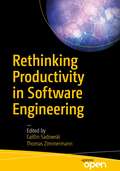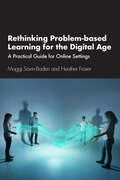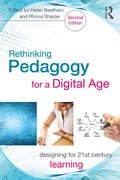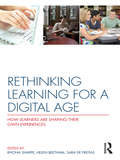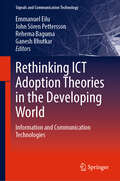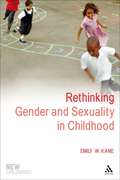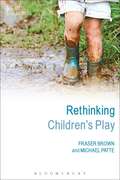- Table View
- List View
Rethinking the Internet of Things: A Scalable Approach to Connecting Everything
by Francis daCosta Byron HendersonApress is proud to announce that Rethinking the Internet of Things was a 2014 Jolt Award Finalist, the highest honor for a programming book. And the amazing part is that there is no code in the book.Over the next decade, most devices connected to the Internet will not be used by people in the familiar way that personal computers, tablets and smart phones are. Billions of interconnected devices will be monitoring the environment, transportation systems, factories, farms, forests, utilities, soil and weather conditions, oceans and resources.Many of these sensors and actuators will be networked into autonomous sets, with much of the information being exchanged machine-to-machine directly and without human involvement. Machine-to-machine communications are typically terse. Most sensors and actuators will report or act upon small pieces of information - "chirps". Burdening these devices with current network protocol stacks is inefficient, unnecessary and unduly increases their cost of ownership. This must change. The architecture of the Internet of Things must evolve now by incorporating simpler protocols toward at the edges of the network, or remain forever inefficient. Rethinking the Internet of Things describes reasons why we must rethink current approaches to the Internet of Things. Appropriate architectures that will coexist with existing networking protocols are described in detail. An architecture comprised of integrator functions, propagator nodes, and end devices, along with their interactions, is explored.
Rethinking Quaternions (Synthesis Lectures on Computer Graphics and Animation)
by Ron GoldmanQuaternion multiplication can be used to rotate vectors in three-dimensions. Therefore, in computer graphics, quaternions have three principal applications: to increase speed and reduce storage for calculations involving rotations, to avoid distortions arising from numerical inaccuracies caused by floating point computations with rotations, and to interpolate between two rotations for key frame animation. Yet while the formal algebra of quaternions is well-known in the graphics community, the derivations of the formulas for this algebra and the geometric principles underlying this algebra are not well understood. The goals of this monograph are to provide a fresh, geometric interpretation for quaternions, appropriate for contemporary computer graphics, based on mass-points; to present better ways to visualize quaternions, and the effect of quaternion multiplication on points and vectors in three dimensions using insights from the algebra and geometry of multiplication in the complex plane; to derive the formula for quaternion multiplication from first principles; to develop simple, intuitive proofs of the sandwiching formulas for rotation and reflection; to show how to apply sandwiching to compute perspective projections. In addition to these theoretical issues, we also address some computational questions. We develop straightforward formulas for converting back and forth between quaternion and matrix representations for rotations, reflections, and perspective projections, and we discuss the relative advantages and disadvantages of the quaternion and matrix representations for these transformations. Moreover, we show how to avoid distortions due to floating point computations with rotations by using unit quaternions to represent rotations. We also derive the formula for spherical linear interpolation, and we explain how to apply this formula to interpolate between two rotations for key frame animation. Finally, we explain the role of quaternions in low-dimensional Clifford algebras, and we show how to apply the Clifford algebra for R3 to model rotations, reflections, and perspective projections. To help the reader understand the concepts and formulas presented here, we have incorporated many exercises in order to clarify and elaborate some of the key points in the text. Table of Contents: Preface / Theory / Computation / Rethinking Quaternions and Clif ford Algebras / References / Further Reading / Author Biography
Rethinking Productivity in Software Engineering
by Thomas Zimmermann Caitlin SadowskiGet the most out of this foundational reference and improve the productivity of your software teams. This open access book collects the wisdom of the 2017 "Dagstuhl" seminar on productivity in software engineering, a meeting of community leaders, who came together with the goal of rethinking traditional definitions and measures of productivity.The results of their work, Rethinking Productivity in Software Engineering, includes chapters covering definitions and core concepts related to productivity, guidelines for measuring productivity in specific contexts, best practices and pitfalls, and theories and open questions on productivity. You'll benefit from the many short chapters, each offering a focused discussion on one aspect of productivity in software engineering.Readers in many fields and industries will benefit from their collected work. Developers wanting to improve their personal productivity, will learn effective strategies for overcoming common issues that interfere with progress. Organizations thinking about building internal programs for measuring productivity of programmers and teams will learn best practices from industry and researchers in measuring productivity. And researchers can leverage the conceptual frameworks and rich body of literature in the book to effectively pursue new research directions.What You'll LearnReview the definitions and dimensions of software productivitySee how time management is having the opposite of the intended effectDevelop valuable dashboardsUnderstand the impact of sensors on productivityAvoid software development wasteWork with human-centered methods to measure productivityLook at the intersection of neuroscience and productivityManage interruptions and context-switchingWho Book Is ForIndustry developers and those responsible for seminar-style courses that include a segment on software developer productivity. Chapters are written for a generalist audience, without excessive use of technical terminology.
Rethinking Problem-based Learning for the Digital Age: A Practical Guide for Online Settings
by Maggi Savin-Baden Heather FraserRethinking Problem-based Learning for the Digital Age provides grounded, evidence-based strategies for teaching faculty, academic developers and educational technologists who are changing their problem-based learning (PBL) modules and programmes from face-to-face to online. Given today’s rapid advancements in learning and curriculum development specific to online and blended modes, there is considerable potential to introduce new forms of PBL in higher education. This book applies fundamental and cutting-edge research, including original scholarship by the authors, to innovative PBL practices and realistic tasks that can be brought to life through digital environments, teamwork and resources. Whether re-contextualizing PBL practices for newly online/blended instruction or seeking fresh PBL approaches for existing digital education environments across disciplines, readers will be guided to construct active, highly motivating, learner-centred experiences using simulations, games, virtual reality, multimedia and other complex innovations.
Rethinking Problem-based Learning for the Digital Age: A Practical Guide for Online Settings
by Maggi Savin-Baden Heather FraserRethinking Problem-based Learning for the Digital Age provides grounded, evidence-based strategies for teaching faculty, academic developers and educational technologists who are changing their problem-based learning (PBL) modules and programmes from face-to-face to online. Given today’s rapid advancements in learning and curriculum development specific to online and blended modes, there is considerable potential to introduce new forms of PBL in higher education. This book applies fundamental and cutting-edge research, including original scholarship by the authors, to innovative PBL practices and realistic tasks that can be brought to life through digital environments, teamwork and resources. Whether re-contextualizing PBL practices for newly online/blended instruction or seeking fresh PBL approaches for existing digital education environments across disciplines, readers will be guided to construct active, highly motivating, learner-centred experiences using simulations, games, virtual reality, multimedia and other complex innovations.
Rethinking Pedagogy for a Digital Age: Designing for 21st Century Learning (PDF)
by Helen Beetham Rhona SharpeThrough a critical discussion of the issues surrounding the design, sharing and reuse of learning activities, the second edition of Rethinking Pedagogy for a Digital Age examines a wide range of perspectives on effectively designing and delivering learning activities to ensure that future development is pedagogically sound, learner-focused, and accessible. This powerful book: • examines the reality of design in practice • shares tools and resources to guide practice • analyses design within complex systems • discusses the influence of open resources on design • includes design principles for mobile learning • explores practitioner development in course teams • presents scenarios for design for learning in an uncertain future Illustrated by case studies from across disciplines and supported by a helpful appendix of tools and resources for researchers, practitioners and teachers, the second edition of Rethinking Pedagogy for a Digital Age is an essential guide to designing for 21st Century learning.
Rethinking Pedagogy for a Digital Age: Designing for 21st Century Learning
by Helen Beetham Rhona SharpeThrough a critical discussion of the issues surrounding the design, sharing and reuse of learning activities, the second edition of Rethinking Pedagogy for a Digital Age examines a wide range of perspectives on effectively designing and delivering learning activities to ensure that future development is pedagogically sound, learner-focused, and accessible. This powerful book: • examines the reality of design in practice • shares tools and resources to guide practice • analyses design within complex systems • discusses the influence of open resources on design • includes design principles for mobile learning • explores practitioner development in course teams • presents scenarios for design for learning in an uncertain future Illustrated by case studies from across disciplines and supported by a helpful appendix of tools and resources for researchers, practitioners and teachers, the second edition of Rethinking Pedagogy for a Digital Age is an essential guide to designing for 21st Century learning.
Rethinking Learning for a Digital Age: How Learners are Shaping their Own Experiences
by Rhona Sharpe Helen Beetham Sara de FreitasRethinking Learning for a Digital Age addresses the complex and diverse experiences of learners in a world embedded with digital technologies. The text combines first-hand accounts from learners with extensive research and analysis, including a developmental model for effective e-learning, and a wide range of strategies that digitally-connected learners are using to fit learning into their lives. A companion to Rethinking Pedagogy for a Digital Age (2007), this book focuses on how learners’ experiences of learning are changing and raises important challenges to the educational status quo. Rethinking Learning for a Digital Age: moves beyond stereotypes of the "net generation" to explore the diversity of e-learning experiences today analyses learners' experiences holistically, across the many technologies and learning opportunities they encounter reveals digital-age learners as creative actors and networkers in their own right, who make strategic choices about their use of digital applications and learning approaches. Today’s learners are active participants in their learning experiences and are shaping their own educational environments. Professors, learning practitioners, researchers, and policy-makers will find Rethinking Learning for a Digital Age invaluable for understanding the learning experience, and shaping their own responses.
Rethinking Learning for a Digital Age: How Learners are Shaping their Own Experiences
by Rhona Sharpe Helen Beetham Sara de FreitasRethinking Learning for a Digital Age addresses the complex and diverse experiences of learners in a world embedded with digital technologies. The text combines first-hand accounts from learners with extensive research and analysis, including a developmental model for effective e-learning, and a wide range of strategies that digitally-connected learners are using to fit learning into their lives. A companion to Rethinking Pedagogy for a Digital Age (2007), this book focuses on how learners’ experiences of learning are changing and raises important challenges to the educational status quo. Rethinking Learning for a Digital Age: moves beyond stereotypes of the "net generation" to explore the diversity of e-learning experiences today analyses learners' experiences holistically, across the many technologies and learning opportunities they encounter reveals digital-age learners as creative actors and networkers in their own right, who make strategic choices about their use of digital applications and learning approaches. Today’s learners are active participants in their learning experiences and are shaping their own educational environments. Professors, learning practitioners, researchers, and policy-makers will find Rethinking Learning for a Digital Age invaluable for understanding the learning experience, and shaping their own responses.
Rethinking Law, Regulation, and Technology (Rethinking Law series)
by Roger BrownswordThis insightful book presents a radical rethinking of the relationship between law, regulation, and technology. While in traditional legal thinking technology is neither of particular interest nor concern, this book treats modern technologies as doubly significant, both as major targets for regulation and as potential tools to be used for legal and regulatory purposes. It explores whether our institutions for engaging with new technologies are fit for purpose.Having depicted a legal landscape that includes legal rules and principles, regulatory frameworks, technical measures and technological governance, this thought-provoking book presents further exercises in rethinking. These exercises confront communities with a fundamental question about how they are to be governed—by humans using rules or by technical measures and technological management? Chapters rethink the traditional arguments relating to legality, the rule of law, legitimacy, regulatory practice, dispute resolution, crime and control, and authority and respect for law. Examining the role of lawyers and law schools in an age of governance by smart technologies, Rethinking Law, Regulation, and Technology will be a key resource for students and scholars of law and technology, digital innovation and regulation and the law.
Rethinking Knowledge Management: From Knowledge Objects to Knowledge Processes (Information Science and Knowledge Management #12)
by Claire R. McInerney Ronald E. DayThis book readdresses fundamental issues in knowledge management, leading to a new area of study: knowledge processes. McInerney’s and Day’s superb authors from various disciplines offer new and exciting views on knowledge acquisition, generation, sharing and management in a post-industrial environment. Their contributions discuss problems of knowledge acquisition, handling, and learning from a variety of perspectives.
Rethinking Innovation and Design for Emerging Markets: Inside the Renault Kwid Project
by Christophe Midler Bernard Jullien Yannick LungThe authors have put together a fascinating narrative of the creation process of one of the most successful example of frugal engineering in recent years. They bring out insightful details of what managerial, organizational and technological pathways were taken to come up with a disruptive innovation that has the potential to change the entry-level automobile market in India and other emerging markets. The book significantly deepens and extends the knowledge of disruptive and reverse innovation, as well as of strategic alliance management. The book keeps the reader captive and is a must read for all who have an interest in innovation.
Rethinking Innovation and Design for Emerging Markets: Inside the Renault Kwid Project
by Christophe Midler Bernard Jullien Yannick LungThe authors have put together a fascinating narrative of the creation process of one of the most successful example of frugal engineering in recent years. They bring out insightful details of what managerial, organizational and technological pathways were taken to come up with a disruptive innovation that has the potential to change the entry-level automobile market in India and other emerging markets. The book significantly deepens and extends the knowledge of disruptive and reverse innovation, as well as of strategic alliance management. The book keeps the reader captive and is a must read for all who have an interest in innovation.
Rethinking ICT Adoption Theories in the Developing World: Information and Communication Technologies (Signals and Communication Technology)
by Emmanuel Eilu Ganesh Bhutkar Rehema Baguma John Sören PetterssonThis book provides extended frameworks and models to help with the adoption of information and communication technologies (ICT) in developing countries. The book first discusses the extent to which conventional ICT theories can be rigid in nature, often unable to handle the constant advances in technology, and technology adoption, implementation, usage, and disposal, not to mention different needs and cost availability in developing countries. The authors go on to show how new and revised models, tested in many societies in developing countries, can solve this mismatch. The authors provide examples of successful ICT adoption in developing country settings, in the areas of agriculture, culture, forestry, education, economics, health, and governance. The authors also show how techniques from persuasive design, philosophical designs, and motivational designs have been adjusted to facilitate successful ICT adoption, implementation, usage, and disposal in targeted regions.
Rethinking Hypermedia: The Microcosm Approach (Electronic Publishing Series #4)
by Wendy Hall Hugh Davis Gerard HutchingsRethinking Hypermedia: The Microcosm Approach is essentially the story of the Microcosm hypermedia research and development project that started in the late 1980's and from which has emerged a philosophy that re-examines the whole concept of hypermedia and its role in the evolution of multimedia information systems. The book presents the complete story of Microcosm to date. It sets the development of Microcosm in the context of the history of the subject from which it evolved, as well as the developments in the wider world of technology over the last two decades including personal computing, high-speed communications, and the growth of the Internet. These all lead us towards a world of global integrated information environments: the publishing revolution of the 20th century, in principle making vast amounts of information available to anybody anywhere in the world. Rethinking Hypermedia: The Microcosm Approach explains the role that open hypermedia systems and link services will play in the integrated information environments of the future. It considers issues such as authoring, legacy systems and data integrity issues, and looks beyond the simple hypertext model provided in the World Wide Web and other systems today to the world of intelligent information processing agents that will help us deal with the problems of information overload and maintenance. Rethinking Hypermedia: The Microcosm Approach will be of interest to all those who are involved in designing, implementing and maintaining hypermedia systems such as the World Wide Web by setting the groundwork for producing a system that is both easy to use and easy to maintain. Rethinking Hypermedia: The Microcosm Approach is essential reading for anyone involved in the provision of online information.
Rethinking Gender and Sexuality in Childhood (New Childhoods #14)
by Emily W. KaneRethinking Gender and Sexuality in Childhood explores gender and sexuality in children's lives, from early childhood through adolescence, bringing together key inter-disciplinary perspectives. Kane explores how childhood gender and sexuality are constructed, resisted, and refined within children's peer cultures, within social institutions like the family, education, and media and the role the state holds in structuring children's lives - defining their rights and opportunities through gender and sexuality-related policies and programs.Examples of research, interviews, activities, key points and guidance on further reading encourage the reader to actively engage with the material and to develop a critical relationship with the content.Rethinking Gender and Sexuality in Childhood is essential for those studying childhood at undergraduate and graduate level and of great interest to those working with children in any field.
Rethinking Gender and Sexuality in Childhood (New Childhoods)
by Emily W. Kane Phil JonesRethinking Gender and Sexuality in Childhood explores gender and sexuality in children's lives, from early childhood through adolescence, bringing together key inter-disciplinary perspectives. Kane explores how childhood gender and sexuality are constructed, resisted, and refined within children's peer cultures, within social institutions like the family, education, and media and the role the state holds in structuring children's lives - defining their rights and opportunities through gender and sexuality-related policies and programs.Examples of research, interviews, activities, key points and guidance on further reading encourage the reader to actively engage with the material and to develop a critical relationship with the content.Rethinking Gender and Sexuality in Childhood is essential for those studying childhood at undergraduate and graduate level and of great interest to those working with children in any field.
Rethinking Ethics Through Hypertext
by Dominic GarciaThis book considers how social justice and authentic freedom of speech could be better tackled through hypertextual writing. Unilinear writing produces an artificial understanding of justice, freedom of speech and hermeneutics. In contrast, hypertextual writing promises an optimistic future which involves less judgment, more empathy and the embracing of difference, so vital in our post-truth culture. The author argues that hypertextual writing is set to have a marked impact on fields like jurisprudence, social sciences and education. Rethinking Ethics Through Hypertext reconciles traditional theories of ethics by re-framing them through hypertextual techniques, bringing together contrasting and contradictory ethical views. It presents compelling insights for scholars of moral philosophy, social justice, hermeneutics and education.
Rethinking Ethics Through Hypertext
by Dominic GarciaThis book considers how social justice and authentic freedom of speech could be better tackled through hypertextual writing. Unilinear writing produces an artificial understanding of justice, freedom of speech and hermeneutics. In contrast, hypertextual writing promises an optimistic future which involves less judgment, more empathy and the embracing of difference, so vital in our post-truth culture. The author argues that hypertextual writing is set to have a marked impact on fields like jurisprudence, social sciences and education. Rethinking Ethics Through Hypertext reconciles traditional theories of ethics by re-framing them through hypertextual techniques, bringing together contrasting and contradictory ethical views. It presents compelling insights for scholars of moral philosophy, social justice, hermeneutics and education.
Rethinking Cyber Warfare: The International Relations of Digital Disruption
by R. David EdelmanFifteen years into the era of ?cyber warfare,? are we any closer to understanding the role a major cyberattack would play in international relations - or to preventing one? Uniquely spanning disciplines and enriched by the insights of a leading practitioner, Rethinking Cyber Warfare provides a fresh understanding of the role that digital disruption plays in contemporary international security. Focusing on the critical phenomenon of major cyberattacks against wired societies, the book reconsiders central tenets that shaped global powers' policies and explains what forces in the international system might durably restrain their use. Arming the reader with the key technological and historical context to make sense of cyberattacks, it explores how deterrence, international law, and normative taboos operate today to shape whether and how states think about causing this kind of disruption - and how soon those forces might combine to rethink those decisions entirely. The result is a comprehensive look at one of the most pressing issues in international security that also illuminates a new pathway for managing one of its greatest sources of instability.
Rethinking Cyber Warfare: The International Relations of Digital Disruption
by R. David EdelmanFifteen years into the era of ?cyber warfare,? are we any closer to understanding the role a major cyberattack would play in international relations - or to preventing one? Uniquely spanning disciplines and enriched by the insights of a leading practitioner, Rethinking Cyber Warfare provides a fresh understanding of the role that digital disruption plays in contemporary international security. Focusing on the critical phenomenon of major cyberattacks against wired societies, the book reconsiders central tenets that shaped global powers' policies and explains what forces in the international system might durably restrain their use. Arming the reader with the key technological and historical context to make sense of cyberattacks, it explores how deterrence, international law, and normative taboos operate today to shape whether and how states think about causing this kind of disruption - and how soon those forces might combine to rethink those decisions entirely. The result is a comprehensive look at one of the most pressing issues in international security that also illuminates a new pathway for managing one of its greatest sources of instability.
Rethinking Children's Play (New Childhoods)
by Fraser Brown Michael PatteRethinking Children's Play examines attitudes towards, and experiences of, children's play. Fraser Brown and Michael Patte draw on a wide range of thought, research and practice from different fields and countries to debate, challenge and re-appraise long held beliefs, attitudes and ways of working and living with children in the play environment.Children need to play and the benefits of play are many and varied, but they are too often underestimated by parents, educators, politicians and society in general. The authors apply a playwork perspective to a wide range of settings populated by children, both formal and informal, to explore the idea that children's learning and development derives substantially from their opportunities to engage with a rich play environment that is supportive of the play process.Thoughts are provoked through examples of research, reflections on research, activities, key points and guidance on further reading.Rethinking Children's Play is essential for all those studying childhood at undergraduate and graduate level and of great interest to those working with children in any field.
Rethinking Children's Play (New Childhoods)
by Fraser Brown Michael Patte Phil JonesRethinking Children's Play examines attitudes towards, and experiences of, children's play. Fraser Brown and Michael Patte draw on a wide range of thought, research and practice from different fields and countries to debate, challenge and re-appraise long held beliefs, attitudes and ways of working and living with children in the play environment.Children need to play and the benefits of play are many and varied, but they are too often underestimated by parents, educators, politicians and society in general. The authors apply a playwork perspective to a wide range of settings populated by children, both formal and informal, to explore the idea that children's learning and development derives substantially from their opportunities to engage with a rich play environment that is supportive of the play process.Thoughts are provoked through examples of research, reflections on research, activities, key points and guidance on further reading.Rethinking Children's Play is essential for all those studying childhood at undergraduate and graduate level and of great interest to those working with children in any field.
Rethinking Children and Research: Attitudes in Contemporary Society (New Childhoods)
by Mary Kellett Phil JonesRethinking Children and Research considers the way people approach research into childhood and children's lives and examines the debates concerning the forms and goals of such research.Theoretical and practice-based perspectives are discussed in the context of recent key developments in research theory and philosophy of children. Mary Kellett promotes the idea that researchers should listen to the voices and perspectives of children as experts on their own lives, and offers insights and guidance on approaches to research design, implementation and presentation.Recent debates and developments are considered, including ethics, approaching research with children from a child-rights framework, and rethinking the power dynamic within research relationships with children.Rethinking Children and Research is essential for studying childhood and undergraduate or postgraduate level, and will be of interest to all involved with research into childhood and children's lives in the areas of education, health and social services.


